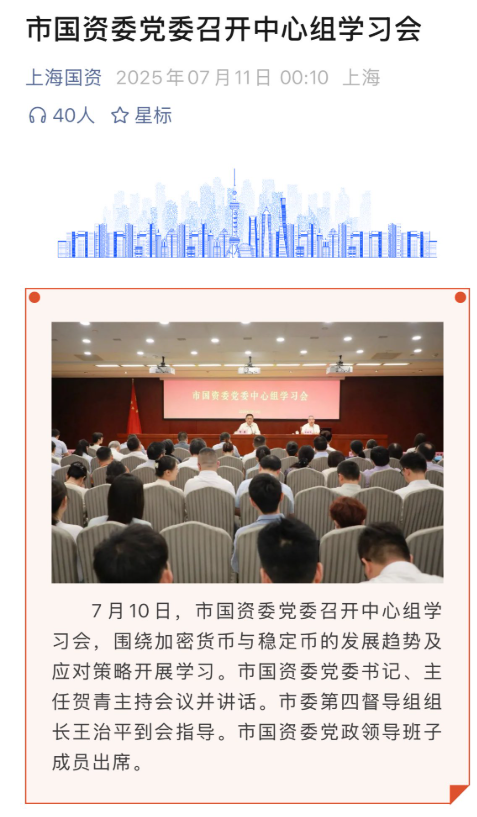Midnight Announcement and the Green Candle of $5,000
At midnight on July 11, 2025, a seemingly ordinary official WeChat public account push triggered a massive wave in the cryptocurrency community in China and globally. The publisher was the Shanghai State-owned Assets Supervision and Administration Commission (abbreviated as "Shanghai SASAC"), and the content was about a central group learning meeting held on July 10, focusing on the "Development Trends and Response Strategies of Cryptocurrencies and Stablecoins".

As soon as the news broke, the market responded in the most direct and primitive way. In the following hours, Bitcoin's price soared from around $111,300, reaching over $118,400, drawing a massive green candle of over $7,000 and creating a new historical high. Accompanying the price surge was a dramatically amplified trading volume, clearly indicating that a powerful buying force was instantly activated. The most sensitive nerve in the cryptocurrency market has always been the "policy sentiment".
This raises a core question: Why could an internal learning meeting of a local state-owned assets management department trigger such a violent price fluctuation for top global crypto assets? What subtle hints did the "smart money" in the market read from this brief announcement? The answer lies not on the text's surface, but deeply embedded in China's complex attitude towards cryptocurrencies over the past decade, Hong Kong's unique role as a financial special zone, and the grand narrative of digital finance's future. What the market is trading is not the meeting itself, but the potential strategic shift it implies.
[The translation continues in the same manner for the rest of the text, maintaining the specified translations for specific terms.]The openness of Hong Kong and Shanghai's exploration have formed a perfect strategic synergy. The CNHC (offshore RMB stablecoin) conceived by Shanghai undoubtedly finds its ideal issuance location and testing ground in Hong Kong. By being issued through a licensed institution regulated by the Hong Kong Monetary Authority, CNHC can compete globally with US dollar stablecoins, while potential financial risks are absorbed by Hong Kong's mature regulatory system and independent financial firewall, without directly impacting the mainland. This is the essence of the "One Country, Two 'Cryptos'" strategy. It allows China to simultaneously achieve two seemingly contradictory goals: maintaining financial system stability and strict capital controls on the mainland, while actively participating in global digital financial innovation and competition, vying for the discourse power of the next-generation internet.
Top-Level Design Game: Another Voice Beyond the Shanghai-Hong Kong Model
However, the "sandbox" model of Shanghai-Hong Kong linkage, though ingenious and prudent, has also sparked deeper strategic contemplation. One perspective argues that this approach of focusing on offshore markets and limited pilot programs may not fully leverage China's core scale advantage as the world's second-largest economy. In the comprehensive digital financial competition with the United States, relying solely on Hong Kong as a "special zone" window may be insufficient to form overwhelming competitiveness.
This voice calls for China to fundamentally review and define the virtual capital market from a more grand national perspective. The core is to squarely face and distinguish two fundamentally different financial needs: "investment-type" and "speculation-type". In their view, stablecoins are essentially closer to a speculative financial market investment chip, with their primary function serving high-frequency trading and risk hedging, rather than direct payment or value storage. Avoiding its "speculation" attribute is tantamount to burying one's head in the sand.
Based on this understanding, a bolder blueprint emerges. In this conception, Shanghai and Hong Kong will play distinctly different but complementary roles. Shanghai, as China's economic heart, should focus on building the "investment-type" financial virtual capital market. Its core task is to vigorously promote digital RMB (e-CNY), serving the digital transformation of the real economy, providing a financing platform based on real assets and future rights for massive enterprises, families, and individuals, completely stripping away pure financial speculation functions. Hong Kong, meanwhile, should be crafted into a strictly regulated, internationalized "speculation-type" financial virtual capital market. Here, compliant RMB stablecoins will serve as one of the core trading mediums, directly confronting US dollar stablecoins, and providing a credible "RMB solution" for the global virtual economy.
To realize this grand blueprint, infrastructure must lead the way. The concept of establishing a "China Digital Network" company similar to the "State Grid" has emerged. This company will be responsible for building a world-class blockchain underlying platform, ensuring convenient, safe, efficient, and low-cost transactions. Simultaneously, clarifying the role of state-owned financial capital is crucial. They should not participate in market competition as ordinary players but should bear the "national team" mission, focusing on strategic investments that execute national will, such as saturated angel round investments in critical technological fields or serving as the ultimate stabilizer when markets fail.
Two Futures of the New Chessboard
When we interweave all the clues and perspectives, the significance of this Shanghai State-owned Assets Supervision and Administration Commission's study session transcends a single policy signal. It's more like a crossroad signpost pointing to two possibilities for China's digital financial strategy.
The first future is the current incremental path represented by Shanghai-Hong Kong linkage. It is cautious and pragmatic, carefully extending tentacles through "electronic enclosures" and offshore experimental fields, attempting to open a new path for RMB internationalization and RWA under strict risk control, without changing the existing domestic financial landscape. This is the wisdom of "crossing the river by feeling the stones", aiming to turn small victories into big wins.
The second future is a more profound, top-down systemic transformation. It requires decision-makers to face the binary attributes of virtual capital, strategically dividing the market into "investment" and "speculation", allowing Shanghai and Hong Kong to perform their respective duties, supplemented by national-level digital infrastructure construction. This is undoubtedly a larger chess game, intending to achieve success in one move, not just participating in the game but reshaping its rules.
Therefore, today's market green candle that surged by 7,000 dollars contains emotions far more complex than imagined. It is not just an instant pricing of the "openness" signal, but an intense game and imagination of which path China will choose in the future. What traders are betting on is the possibility of the world's second-largest economy transforming from a "strict regulator" in the crypto world to a "controlled participant", and ultimately becoming a "rule-maker". The midnight announcement may not be a starting gun, but the opening bell of this grand chessboard concerning China's digital financial national destiny.





